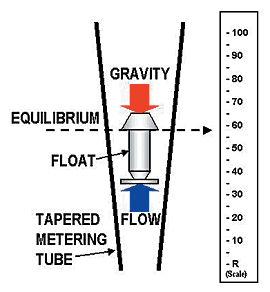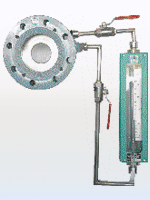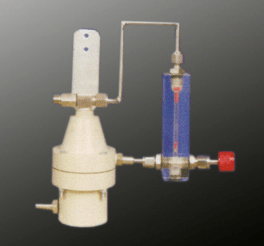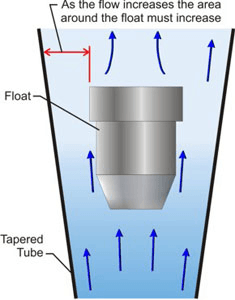Rotameters Information
Rotameters are also known as variable area flow meters. Variable area flow meters work by measuring the flow rate as the fluid travels through a tapered tube where the cross sectional area of the tube gradually becomes greater as the fluid travels through the tube. The term rotameter comes from the early version of the floats, which had slots to help stabilize and center them within the fluid flow. This caused the floats to rotate. Current float designs are a variety of shapes (spherical for example) and are constructed of stainless steel, glass, metal, and plastic.

Rotameter design. Image Credit: SensorsMag
The tapered glass tubes are positioned vertically in the fluid flow since the float position is based on gravity. As liquid enters the bottom of the tube, the float begins to rise. A float within the tube rides upward in relation to the amount of flow. When there is no liquid flow, the float rests freely at the bottom of the rotameter. The tube size varies from 1/16 to 4 inches, with a 1/8 to 2 inch range being the most common.
Rotameters have a graduated scale on the the side to allow the operator to take measurements. It's critical that the device is calibrated to a specific fluid with a known specific gravity since specific gravity can have great impact on the accuracy and reliability of the rotameter. An example of calibration fluid is water with a specific gravity of 1.0. Rotameters can be calibrated for a wide range of fluids by understanding basic operating principles. The accuracy of a rotameter is determined by the accuracy of the pressure, temperature, and flow control during the initial calibration. Changes to the density and weight of the float, as well as changes which affect the fluid such as pressure or temperature, will impact the rotameter reading. It is recommended that the rotameter be calibrated yearly to account for changes in the system.
Rotameter function. Video Credit: BTCInstrumentation / CC BY 3.0
The volumetric flow (in cubic meters per second) of fluid running through the conic pipe of a rotameter is
![]()
where:
![]() is the the discharge coefficient of the fluid flow through the tube.
is the the discharge coefficient of the fluid flow through the tube.
![]() is the the least surface of the annular orifice of the fluid flow, corresponding to the height of the float H with respect to the initial section of the pipe,
is the the least surface of the annular orifice of the fluid flow, corresponding to the height of the float H with respect to the initial section of the pipe, ![]()
![]() is the acceleration of the float mass,
is the acceleration of the float mass,![]()
![]() is the float length
is the float length
and

![]() is the float density,
is the float density, ![]() is the fluid density
is the fluid density
There are several features that make variable area flow meters useful for many applications. Variable area flow meters offer mechanical flow measurement while using a single moving part. This ensures measurement reliability and easy installation. It also means that the rotameter can be used in areas with no power. These are highly versatile devices due to the variety of construction materials, inlet and outlet sizes, and types. Variable area flow meters offer low pressure drops, linear scales, and electronic output availability. These features allow for easier measurement interpretation and the preservation of mechanical flow measurement. Rotameters are tapered-tube devices that have high accuracy at low flow rates and are inexpensive when the tube is glass or plastic.
The disadvantages of rotameters are that is must be installed vertically with the fluid flowing up through it, and the graduated scale will only be valid for the specific fluid and conditions where it was calibrated. While rotameter floats are generally insensitive to viscosity, the operator should still verify that any rotameter installed is calibrated to their specific setup.
Types of Rotameters
Rotameters can be adapted to be used for a particular application.
Orifice bypass - Rotameters can be installed in a bypass line around an orifice plate to handle larger flow rates. The differential pressure in the liquid or gas (caused by the orifice plate) creates a relatively low flow through the rotameter that can be a measure of flow through the main pipeline. These devices are especially useful in hazardous or remote areas, or where there is no electric power. The scale readings can be graduated in direct units for flow in the main pipeline and the tube can be adjusted or cleaned without disassembling or removing the meter.

Orifice bypass rotameters
Image Credit: RSA Instruments Pvt. Ltd.
Purgemeters - Purgemeters are the most popular type of flow meter. They are designed to facilitate setting and accurately controlling low flow rates, typically in the purging of liquid or gas from measurement piping. What makes them useful for purging applications is that they have a constant-flow dp regulator to maintain purge flow rate at the desired level. The desired purge rate can be set using a needle valve and simple devices require no external power. Below is a list of sample applications for purgemeters:
- Bubble tube purge for liquid level measurement
- Purging pressure taps of orifice flowmeters
- Continuous forced lubrication of bearings
- Bubble tube purge for density measurement
- Purgemeters with gas analyzers

Purgemeters. Image Credit: Shreeji
Specifications
Important parameters to consider when specifying rotameters include:
Flow rates
- Liquid volumetric flow rate- Liquid volumetric flow rate applies only to those rotameters that are liquid volumetric flow sensors or meters. It is expressed as the range of flow in volume/time.
- Gas volumetric flow rate- Gas volumetric flow rate applies only to those rotameters that are gas volumetric flow sensors or meters. It is the range of flow in volume/time.
- For more information on flow rate calculations please read How to Select Flow Switches.
Operating pressure - The operating pressure is the maximum head pressure of the process media the meter can withstand. This is especially important for gas as it can change the density of the gas.
Fluid temperature - The maximum temperature of the media that can be monitored is usually dependent on construction and liner materials.
Pipe diameter - Pipe diameter is also important to consider, especially when specifying specific mounting options.
Indicating scale-type - This may be personal preference or a need based on the standards of the system. Examples of indicating scale-types include percent, directing reading (desired units), or some other format that meets the needs of the process.
Valve requirements- A valve is not needed for applications, but the most common valve used with a rotameter is a needle valve.
Media Type
Rotameters can be configured to either measure liquid or gas flow. Measuring the flow of liquids and gases is a critical need in many industrial plants. In some operations, the ability to conduct accurate flow measurements is so important that it can make the difference between making a profit and taking a loss. In other cases, inaccurate flow measurements or failure to take measurements can cause serious (or even disastrous) results. The media is most likely liquid, gas, or steam. It is important to understand the nature of the fluid, such as its corrosive properties, concentration, presence of entrained solids, and the density and viscosity of the fluid in the system.
Density should be noted using specific units, such as grams per cubic centimeter, at a specific operating temperature. Density can also be noted in Fluid-specific gravity -- ratio of media density to the density of water. Viscosity of the media is typically done in specific units such as centipoises or centistrokes at a specified operating temperature.
Materials
The key components of a variable-area rotameter are the tapered tube and the float. The material of both of these pieces should be considered when selecting a rotameter device.
Tube Material
Glass- Borosilicate glass is used to make the tapered metering tube and was the original material used to make rotatmeters. The float is visible in the tube, which also allows the user to observe the system media, and the meter shows flow rate readings directly on scale graduations on the glass surface. They are best used for simple, reliable indication of flow rate with a high level of repeability. Glass rotameters can be fitted with alarm systems if the system goes above or below a set flow rate. They also fit a wide variety of end fittings and connections. Glass tubes can typically handle pressure up to 300 psig, and temperatures up to 250°F.
Metal- Metal tube rotameters are also known as armored meters and are made of corrosion resistant type 316 stainless steel. This type of steel is corrosion resistant and is well suited to measuring steam flow where conditions or granulations prevent the use of glass. They are best suited for high temperature or pressure applications that would exceed the limit of the glass tube. A magnet inside the float is linked to a pointer which indicates the flow rate on the indicating scale. Metal tube meters do not require external electric power. Metal rotameter tubes can be fitted with high/low flow alarms as well as an electric converter that can send the single to a remote indicator, recorder, or controller. Metal tubes can handle pressure up to 1500 psig and temperatures to 900°F.
Plastic- Plastic tube rotameters are a very cost effective alternative to glass or metal. The most common type of plastic used is clear acrylic since it is practically unbreakable in most industrial processes. Plastic rotameters are best suited for applications where metal, wetted parts cannot be tolerated, such as ionized water or corrosive media. Plastic tubes can typically handle pressure up to 100 psig and temperatures to 150°F.
Float Material
Floats are available in a wide variety of shapes, sizes, and materials to suit many applications. Small floats are usually made of black glass, stainless steel, sapphire, Carboloy, or tantalum. Larger floats are made from corrosion-resistant materials. The density of the float can be changed to adjust the meter's range and resist corrosion from the measured fluid. Type 316 stainless steel is the most commonly used material but PVC, Teflon, and tantalum are also available.

Rotameter float. Image Credit: GlobalWater
Mounting Options
Rotameters should always be mounted vertically and with the widest end of the taper at the top. Mounting options for rotameters include insertion types, in-line flanged, in-line threaded, and in-line clamp.
- Insertion flow meters are inserted perpendicular to flow path. They usually require a threaded hole in the process pipe or other means of access.
- In-line flanged flow meters are inserted parallel to the flow path between two pieces of existing flanged process pipes.
- In-line threaded flow meters are inserted parallel to the flow path and threaded into two existing process pipes. NPT is the most common thread type.
Features
|
Audible or Visual Alarms |
Instruments have audible or visual alarms to alert users to dangerous conditions. |
|
Controller Functions |
Devices have or receive sensor input, provide control, (limits, PID, logic, etc.) and output a control signal. |
|
Programmable
|
Typically, programmable meters include a built-in microprocessor. They can be adjusted electronically for different materials, ranges, outputs, etc. |
|
Recorder / Totalizer Functions
|
Totalizer functions totalize the amount of material, media, or process variable controlled. A recorder function may be a datalogger that logs system or process variables and/or control commands for later viewing or analysis. A chart recorder that can plot (chart) flow history or give total flow for a given unit of time may also be available. |
|
Sanitary |
Devices are designed for use in sanitary environments, such as in medical or food processing applications. |
Resources
Sensors Online - The Basics of Rotameters
Omega Engineering Inc. - Introduction to Rotameters
Determination of the Flow Rate of Different Fluids by a Rotameter (pdf)
- gas rotameter
- rotameter lpm
- chlorine rotameter
- high purity rotameter
- rotameter for caustic
- rotameter head loss
- rotameter price
- VDE/VDI 3513
- acrylic tube rotameters
- air purge rotameters
- compressed air rotameters
- high flow air rotameters
- high pressure rotameters
- low air flow rotameters
- low flow liquid rotameters
- natural gas rotameters
- nitrogen gas rotameters
- oxygen flow meter rotameters
- ultra low flow rotameters
